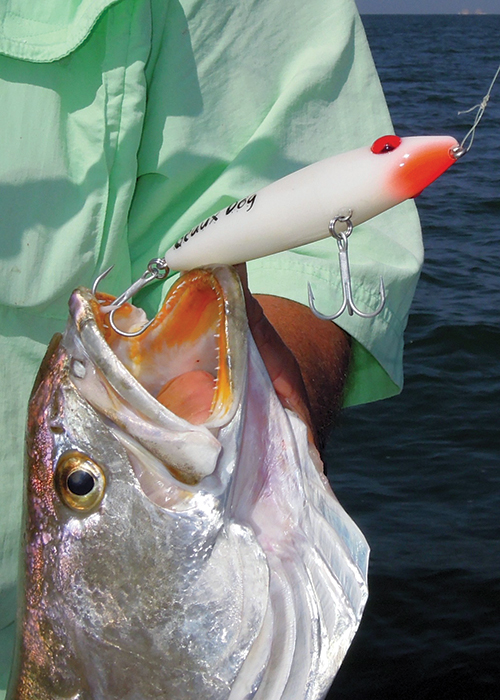
Fishing for bigger trout requires more focused approach
People often hear about that novice who fishes five minutes and lands a fish of a lifetime. Sure, that happens occasionally. Anyone who fishes along the Alabama coast could land a giant speckled trout on any cast with any bait on any day, but to consistently catch trophy trout, anglers need to specifically fish for big trout.
“Fishing for trophy trout requires a lot of patience,” says Richard Rutland with Cold Blooded Fishing of Mobile. “People won’t get a thousand bites a day. If I had to pick months to catch big trout in the Mobile Bay area, I’d say December, January, April and May.”
Anglers fishing for trophy speckled trout might spend long hours casting hundreds of times while hoping for one or two bites. They must ignore nearby anglers filling ice chests with smaller school trout. Bigger trout sometimes follow schooling specks, not to eat the shrimp or baitfish that the schoolies want, but to eat other trout. They lurk beneath the school waiting to pounce on one of their unsuspecting smaller speckled cousins. Also, fish at odd hours like at night when fewer people roam the waters and avoid fishing on holidays or weekends whenever possible.
Loners, big trout often act more like redfish or largemouth bass than other trout. Trophy trout typically lurk around cover to wait for morsels to venture too close. They hang around oyster reefs, rock piles, sunken boats, jetties, gas wells or other hard, irregular structure where they can ambush prey. Humps, isolated reefs or channel drop-offs offer fish access to deep sanctuaries and shallow feeding flats, making them excellent places to look for big trout.

While a giant speck would slurp any shrimp that passes too close, big trout generally prefer to eat finfish. Bigger fish might not feed every day. They typically want to grab one big, slow meal that doesn’t require too much energy to catch rather than chase down a bunch of tiny morsels.
“Bait is the key for catching big trout,” says George Harrison with Harrison Inshore Charters & Guide Service. “In the summer, I look for mullets in water no deeper than six feet deep. The west end of Mobile Bay can produce some big trout. The Mobile River has produced a lot of 6- to 7-pound trout over the years.”
People can catch trophy trout on just about any jig, spoon and other temptation, but large topwater baits frequently produce the most strikes from monster specks. Topwater baits come in poppers, prop baits and walk-the-dog varieties. Some of the best topwaters zigzag across the surface, mimicking wounded baitfish. Many anglers work baits with a continuous retrieve, but big trout frequently attack when a bait slows down or pauses occasionally.
“Topwater baits are great baits for attracting big trout,” Rutland says. “The two biggest trout I ever caught came on Super Spook topwater lures. Both weighed more than eight pounds. I caught one near Sand Island and the other close to the Mobile River. I released both of them.”
When all else fails, offer fish fresh meat. Some excellent live baits include mullets, pogies, also called menhaden, pinfish and croakers. A 5-pound trout can easily swallow a 12-inch mullet. When fishing for big trout, many anglers free-line live baitfish. Others prefer to use popping corks or slip cork rigs that hold baits vertically at pre-determined depths.
“In the spring and early summer, I really like to use live croakers,” Rutland says. “If I can’t find croakers, I’ll use live pogies. I free-line them with just a hook and no weight.”
Pick a good spot with easy access to both deep and shallow water and abundant bait. When fishing with live bait, place several rods in holders. Offer the fish various live temptations at different depths. Put some baits on the shallow side of a drop or structure and some in the depths while free-lining other baits in the mid-depth ranges.
Although Alabama waters rarely produce trout exceeding 10 pounds, the state can produce many trout in the 4- to 8-pound range with some bigger fish. Wilfred A. Ducharme landed the state record, a 12.25-pounder, while fishing off Orange Beach in May 1980.
“For catching a 5- to 7-pound trout, I recommend fishing around Dauphin Island in the spring,” Rutland says. “Fishing oyster flats in April and May can be very good. The area around Dauphin Island bridge is a great area for that. I also like the western end of Dauphin Island, the grass flats on the north side and along the beach on the south side.”¢
For more information, visit: coldbloodedfishing.com and dauphinislandfishingguides.com.
John N. Felsher is a freelance writer and photographer who writes from Semmes, Ala. Contact him through his website at www.JohnNFelsher.com




